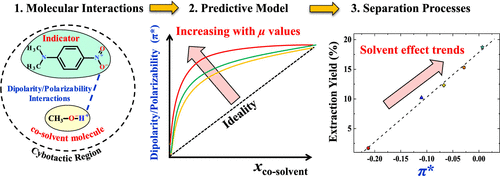当前位置:
X-MOL 学术
›
Ind. Eng. Chem. Res.
›
论文详情
Our official English website, www.x-mol.net, welcomes your
feedback! (Note: you will need to create a separate account there.)
Kamlet–Taft Dipolarity/Polarizability of Binary Mixtures of Supercritical Carbon Dioxide with Cosolvents: Measurement, Prediction, and Applications in Separation Processes
Industrial & Engineering Chemistry Research ( IF 3.8 ) Pub Date : 2020-06-09 , DOI: 10.1021/acs.iecr.0c01251 Alif Duereh 1 , Yuta Sugimoto 1 , Masaki Ota 1, 2 , Yoshiyuki Sato 3 , Hiroshi Inomata 1
Industrial & Engineering Chemistry Research ( IF 3.8 ) Pub Date : 2020-06-09 , DOI: 10.1021/acs.iecr.0c01251 Alif Duereh 1 , Yuta Sugimoto 1 , Masaki Ota 1, 2 , Yoshiyuki Sato 3 , Hiroshi Inomata 1
Affiliation

|
A flow-type apparatus and predictive framework were developed for measuring and estimating dipolarity/polarizability (π*) values of binary mixtures of supercritical carbon dioxide (scCO2)–cosolvents. The π* values of scCO2 with methanol and ethanol cosolvents (up to 10 mol %) are reported at the temperature ranging from 40 to 80 °C and pressure ranging from 10 to 20 MPa and were found to be dependent on fluid density. The predictive framework for scCO2–cosolvent mixtures proposed in this work was the modification by the addition of correction functions (g(ρCO2)) of local density enhancement into the previous predictive framework for binary liquid nonpolar–polar mixtures [ Ind. Eng. Chem. Res. 2019, 58, 18986−18996]. Four g(ρCO2) forms with a function of CO2 density were evaluated by considering literature local density enhancements of pure CO2 obtained from (i) fluorescence, (ii) Raman, (ii) UV–vis spectroscopic techniques, and (iv) molecular dynamics simulations. The framework was applied to the prediction of π* of four scCO2–cosolvent mixtures (methanol, ethanol, 2-propanol, and 1,1,1,2-tetrafluoroethane (HFC134a)) and was found to give a reliable value with an overall relative deviation of 0.03 between the experimental and calculated data, where the fluorescence g(ρCO2) function provided a lower deviation than the other three functions. The application of the framework to separation processes showed that the π* values were found to explain the trends of solubility, extraction yield, and fractionation recovery. The π* values determined from the framework can be used to analyze solvent effect trends in many separation processes that required only cosolvent dipole moment, pure π* component, and CO2 density (pressure and temperature).
中文翻译:

超临界二氧化碳与助溶剂的二元混合物的Kamlet-Taft偶极/极化率:测量,预测和在分离过程中的应用
开发了一种流动型仪器和预测框架,用于测量和估计超临界二氧化碳(scCO 2)-助溶剂的二元混合物的偶极/极化率(π*)值。据报道在40至80°C的温度和10至20 MPa的压力下,scCO 2与甲醇和乙醇助溶剂(最高10 mol%)的π*值被发现与流体密度有关。为SCCO预测框架2个在这项工作中提出-cosolvent混合物是通过加入校正函数(修改克(ρ CO 2))局部密度增强的成二进制液体非极性非极性混合物[先前预测框架工业工程师 化学 Res。 2019, 58,18986-18996]。四克(ρ CO 2)与CO的函数形式2密度被考虑纯CO的文献局部密度的增强评估2选自(i)荧光获得的,(II)拉曼,(II)的UV-vis光谱技术,和( iv)分子动力学模拟。该框架可用于预测四种scCO 2-共溶剂混合物(甲醇,乙醇,2-丙醇和1,1,1,2-四氟乙烷(HFC134a))的π*,并得出可靠的值。的实验和计算的数据,其中,所述荧光之间整体0.03相对偏差克(ρ CO2)函数提供的偏差低于其他三个函数。该框架在分离过程中的应用表明,发现π*值可以解释溶解度,提取率和分馏回收率的趋势。从框架确定的π*值可用于分析许多分离过程中的溶剂效应趋势,这些分离过程仅需要共溶剂偶极矩,纯π*组分和CO 2密度(压力和温度)即可。
更新日期:2020-07-08
中文翻译:

超临界二氧化碳与助溶剂的二元混合物的Kamlet-Taft偶极/极化率:测量,预测和在分离过程中的应用
开发了一种流动型仪器和预测框架,用于测量和估计超临界二氧化碳(scCO 2)-助溶剂的二元混合物的偶极/极化率(π*)值。据报道在40至80°C的温度和10至20 MPa的压力下,scCO 2与甲醇和乙醇助溶剂(最高10 mol%)的π*值被发现与流体密度有关。为SCCO预测框架2个在这项工作中提出-cosolvent混合物是通过加入校正函数(修改克(ρ CO 2))局部密度增强的成二进制液体非极性非极性混合物[先前预测框架工业工程师 化学 Res。 2019, 58,18986-18996]。四克(ρ CO 2)与CO的函数形式2密度被考虑纯CO的文献局部密度的增强评估2选自(i)荧光获得的,(II)拉曼,(II)的UV-vis光谱技术,和( iv)分子动力学模拟。该框架可用于预测四种scCO 2-共溶剂混合物(甲醇,乙醇,2-丙醇和1,1,1,2-四氟乙烷(HFC134a))的π*,并得出可靠的值。的实验和计算的数据,其中,所述荧光之间整体0.03相对偏差克(ρ CO2)函数提供的偏差低于其他三个函数。该框架在分离过程中的应用表明,发现π*值可以解释溶解度,提取率和分馏回收率的趋势。从框架确定的π*值可用于分析许多分离过程中的溶剂效应趋势,这些分离过程仅需要共溶剂偶极矩,纯π*组分和CO 2密度(压力和温度)即可。











































 京公网安备 11010802027423号
京公网安备 11010802027423号